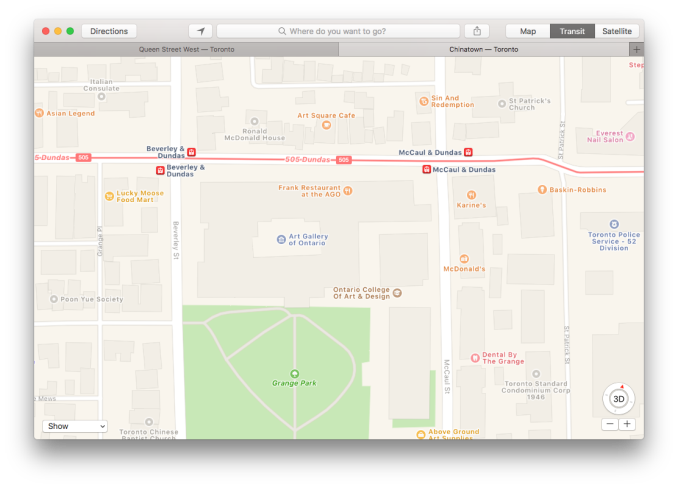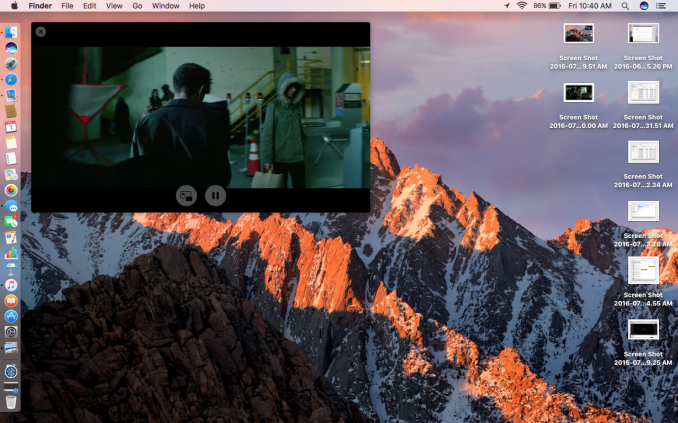A First Look At Apple's macOS Sierra
by Brandon Chester on July 13, 2016 8:00 AM EST- Posted in
- Mac
- Apple
- Operating Systems
- macOS
Tabs For All Windows
Sometimes the best features in a software update are the small additions that end up having a large impact on how you use a device. I think the inclusion of universal tabs on macOS is a great example of this. Everyone who has used a computer should be familar with tabs, as they're a common style of interface for applications that work with many pages or documents that follow the same sort of format. Excel is a great example of a tabbed application that works with many documents of the same type, while web browsers are an example of applications that use tabs to avoid creating a great number of windows that would all have the same interface but with a different internal content pane.
While tabs are certainly useful, there are many applications that allow you to open multiple windows but do not allow you to organize those windows as tabs. With macOS Sierra Apple has implemented a system-level tab manager that works across essentially all applications. The only requirement is really that the application uses macOS's standard window chrome so the tab bar can be easily integrated into the application.
As you can see, the implementation fits in quite well alongside apps that already supported tabs such as Safari and Finder. A rule of thumb is that if an application supports multiple windows, it will now support tabs under macOS Sierra. For applications that work like a browser such as Safari and Apple Maps, using the standard cmd+t shortcut will create a new tab. For other apps like pages where that shortcut has likely been taken, cmd+opt+n opens a new tab, which complements the cmd+n shortcut to open a new window. When in full screen mode cmd+n is overridden to create a new tab, as you can't open a new window in full screen.
I've had some issues with the cmd+opt+n shortcut not working correctly in applications like Pages, which is likely due to Sierra's state as a very early beta. I was able to show tabs working in Pages by using the command in the View menu to make the tab bar render and hitting the button to open a new tab, and the issues with the implementation will hopefully be sorted out by the time Sierra comes into its public beta phase.
Picture in Picture
Picture in Picture or PiP mode is available on iPads as of iOS 9. It allows an application that displays videos to continue playing the video in a floating window even after the user has left the application and gone to another app or the home screen. On the iPad the usefulness of this feature cannot be overstated, as it allows you to continue watching a video while also interacting with two completely different applications in split-screen mode. With macOS Sierra PiP is now available as well, and it works in the same manner as it does on iOS.
Since macOS has windows, Picture in Picture isn't as necessary as it is on the iPad where applications generally take up the entire screen. For example, it's helpful that an iOS video application implements PiP so you can keep watching even if you have to switch to another app, but on macOS that doesn't really matter because your video app has its own window anyway. Where it does come in handy is popping videos out of Safari and displaying them in a floating window while you use other applications or browse other websites.
Like the iPad, the PiP window on macOS snaps itself to one of the four corners of the display and sits atop other applications so it cannot be obstructed. It can be resized to a degree, with the max size being about one quarter of the screen on this 13" MacBook Pro. Out of the box it works with any website that uses the standard Safari HTML5 video player. Unfortunately, sites like YouTube that use their own custom player have to integrate the functionality themselves, but Apple has noted that ESPN and Vimeo have actually done the work to implement this already and you can see an example of that above. iTunes will support PiP when Sierra is officially released, but for now there aren't really any desktop applications that it can be used with, although as I said before, PiP isn't as necessary for video players on macOS as it is on iOS.













81 Comments
View All Comments
Wheaties88 - Wednesday, July 13, 2016 - link
Any chance of being able to just clone a copy of macOS Sierra onto the drive of a non-supported Mac and getting it to boot?DPUser - Wednesday, July 13, 2016 - link
http://forums.macrumors.com/threads/mac-pro-3-1-in...Wheaties88 - Wednesday, July 13, 2016 - link
Thanks. I might have to try that on an older MacBook I have.casperes1996 - Thursday, July 14, 2016 - link
So, just to clarify something.The PiP window doesn't have to snap to the corners of the screen. It's just the default behaviour. If you drag it around while holding command, the floating window can be placed anywhere.
Furthermore, there's also a new, unmentioned window management feature; Snapping. It's not like the Aeuro snap thing on Windows, but moving a window to the edge of another, or resizing it or something, will result in the window, sort of magnetically sticking slightly when it reaches the edge of the other window, or the boundary of the screen. It can still be stretched beyond that point, but it's faster and easier to line things up exactly edge to edge.
Alexey291 - Thursday, July 14, 2016 - link
Oh look more clickbait. Quelle surpriseApePriori - Thursday, July 14, 2016 - link
Thanks for the article, I've been coming here everyday for many years to see what's up. I find no desire to whine about the 95% non-apple content. In fact, I read it happily, because reading is fun and you learn something new every day. Sometimes it takes a day or two before a new article is up. I don't care. Anand took a job at Apple. So what? Good for him, he's a smart guy and why shouldn't he move on? If anything the Apple content has been less since Anand left, since clearly he was excited by the technology and the company. His Apple AX CPU dives were excellent reading, whatever your platform of choice. No matter, Ryan and company have done an excellent job since Anand left, the overall character and content of the site has remained the same.Sadly, one of the things that has never changed are all the pointless complaints that have nothing to do with the content of Apple related articles in particular. It's just a constant barrage of platform identity complex and content entitlement syndrome on full display. It's incredibly tiresome and brings down the quality of an otherwise excellent site. Whining about platforms, disparagement of the editors, fomenting about the ratio of x content to y content, blah blah blah... boring.
Right now there are three articles about apple stuff on the entire home-page scroll of about 45 articles, strangely the apple articles all share an identical flood of complaints about publishing the article while the non-apple articles are followed by relatively sober discussions about the content of the article. Ironically all of this complaining and platform trolling in Apple articles only proves that Anandtech has not changed much at all over time, contrary to what these commenters want to believe. This is still largely a Win/PC and Android focused site with a side of Apple product, pretending otherwise is childish.
Anyway, sincere thanks to all the editors and writers for all of the articles covering all of the platforms over the years here on Anandtech. Don't let the cesspool of the comments get to you, you're doing a great job.
Dennis Travis - Friday, July 15, 2016 - link
Well said.Oxford Guy - Friday, July 15, 2016 - link
Anti-Apple sentiment is a very old thing in the tech world. You haven't gotten use to it by now?ApePriori - Friday, July 15, 2016 - link
Yes, being a mac user since 1988 I am all to familiar with it. Believe me, I ignore it by default and do not generally waste time worrying about it. On the other hand it's 2016, the horse has been flogged into a bloody mist, and the overwhelming stupidity of it all can inspire a rare comment from me regarding same, if you don't mind.ex2bot - Friday, July 15, 2016 - link
Thanks for the article! I appreciate the Apple content, and, as I'm capable of using multiple computing platforms, I appreciate the non-Apple content, too.The comment in the article about iOS having no accessible file system is incorrect. iOS has had accessible files since 2007 when the first iOS device came out.
I know the author actually meant an "open" file system in the sense that files saved by one app are accessible to others, iOS has that, too, since iOS 8. It's called iCloud Drive. The files do exist on Apple's remote servers, but they (can) also exist on the device and they are accessible from other apps. For example, I can access iCloud Drive files saved by various apps in Mail app to attach to email messages.